Lost Molds and Found Dinnerware: Rediscovering Eva Zeisel's Hallcraft
February 11 - September 09, 1999



In the special exhibition, Lost Molds and Found Dinnerware: Rediscovering Eva Zeisel's Hallcraft, Zeisel's strong yet elegant, fluid yet playful dinnerware designs are juxtaposed alongside the equally powerful original plaster molds created in the 1950s at the Hall China Company in East Liverpool, Ohio. The molds served as the tools for mass producing this beautifully designed "best-selling dinner set in the United States." For nearly four decades after production of these captivating wares ceased, the original Hallcraft master molds appeared to be lost, and then through the perseverance of Eva Zeisel and others, the molds were rediscovered in 1998. It is a story not nearly as memorable as the designs themselves, but with a happy ending.
The joy of creating beautiful things for people "to please the eye, and invite the hand to touch" is evident in all of Eva Zeisel's designs, whether produced in ceramic, plastic, metal, wood or glass. She is best known for her ceramic designs including the dinnerware service commissioned in the early 1940's for the Museum of Modern Art. Yet the dinnerware which became "America's fastest-selling modern dinnerware," and Zeisel's most popular design was produced by the Hall China Company in the 1950s -- Hallcraft I (Tomorrow's Classic). The Hallcraft II (Century)line was introduced a few years later, and while considered by some to be aesthetically equal or superior to Hallcraft I, it never became the commercial success of Tomorrow's Classic. At the time, Zeisel was teaching at the Pratt Institute and designed the number one selling dinnerware of the 1950s as a freelance designer.
Production of both Hallcraft lines at Hall China stopped in the late 1950's; the molds sat dormant for decades. Periodically Eva Zeisel would query the management at Hall China concerning the whereabouts of the original plaster block molds. Ultimately there was a question about whether the molds had survived leaking roofs, reorganization of the mold storage area, etc. Persistence on the part of Eva Zeisel paid off in 1998, when she asked a former modeler at Hall China, William Walker, for his assistance in discovering whether the original Hallcraft molds were still in existence. Dr. Walker, who now holds a Ph.D. in ceramic engineering and works at the New York State College of Ceramics at Alfred University, made phone calls and site visits to Hall China and a majority of the lost molds were subsequently rediscovered. The molds for the recovered jiggered pieces were stacked many feet high in the deep, dusty and sometimes damp recesses of the factory, while the slipcasting molds were on the highest storage shelves -- well out of the view of the present factory workers and well out of the memory view of most Hall China management. The pieces were transported to Alfred, New York, to be stored until the pieces could be safely moved to a factory to reproduce this most popular of dinnerware. The molds that were once feared "lost" are now found. The pieces were transported to Alfred, New York, to be stored until the pieces could be safely moved to a factory to reproduce this most popular of dinnerware. The molds that were once feared "lost" are now found. The pieces were transported to Alfred, New York, to be stored until the pieces could be safely moved to a factory to reproduce this most popular of dinnerware. The molds that were once feared "lost" are now found.
The special exhibition, Lost Molds and Found Dinnerware: Rediscovering Eva Zeisel's Hallcraft, gives viewers a chance to see the original master molds that are seldom seen by anyone outside the factory. These plaster molds complete the story of how a designer must design objects for production that make "the best use of the limitations imposed by manufacturing, merchandising or functional requirements." These found molds will allow a new audience, based on a generation of diners and collectors not born during the heyday of Hallcraft production in the 1950s, to hopefully be able to purchase this beautiful dinnerware at fine department stores, and museum shops, in addition to stumbling upon the occasional originals in antique shops and your finer garage sales.

Hallcraft Tomorrows Classic
designed ca. 1949-50
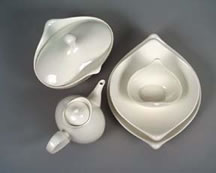
Hallcraft Century designed
ca. 1955
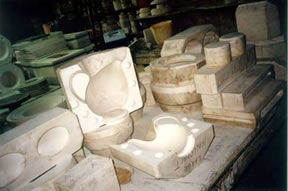
Hallcraft molds in the Hall China moldshop

Mold for Hallcraft Classic gravy boat

Mold for Hallcraft Classic jug
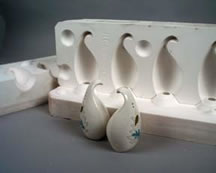
Mold for Hallcraft Salt and Pepper

Holiday pattern

Mulberry pattern

Spring pattern
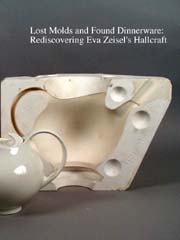
Exhibition Catalogue Available
Lost Molds and Found Dinnerware:
Rediscovering Eva Zeisel's Hallcraft
by Margaret Carney
24 pages. 24 black and white and 5 color
photographs. 1999.
$20.00 prepaid
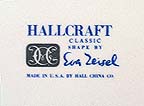
Hallcraft Stamp
(front/back side)
